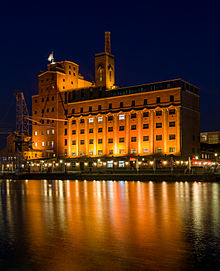Duisburg: Town and Harbour
You can help expand this article with text translated from the corresponding article in German. (July 2019) Click [show] for important translation instructions.
|
51°26′07″N 6°45′46″E / 51.435147°N 6.762692°E
Duisburg: Town and Harbour is the Theme Route No. 1 of the Industrial Heritage Trail, which passes through Duisburg, the Inner Harbour, Ruhrort,[1] the Duisburg-Ruhrorter harbour and other attractions on the Rhine and Ruhr. These trails were first developed between 1989 and 1999.[2]
History
[edit]The concept of grouping together legacy industrial sites to assist and enable them with marketing was developed by North Rhine Westphalia between 1995 and 1999. It came together with partners from Great Britain, the Netherlands and Belgian to apply for Interreg IIC money to develop the idea of the European Route of Industrial Heritageusing test routes in the four countries. In 2001 they produced a report showing the possible structure. The report concluded with the Duisburg Declaration. [3]




The first heritage trail starts in the Inner Harbour of Duisburg and finishes at the lock at Meiderich.[4] The second centres on the Rhine Ruhrort harbours. The Third theme route on features between them. The Duisburg: Industrial Culture on the Rhine is made up these three routes.[5]
The presentation of the route combines a caring attitude to the locations with a scientific attitude and an easily accessible manner of presentation.[6]
Some locations are also included in other theme routes of the Industrial Heritage Trail.[7]
An guide to the Duisburg: Town and Harbour Theme Route, Duisburg: Stadt und Hafen (Themenroute 1) by Dagmar Bungardt and Esher Gudrun has been published by the Regionalverband Ruhr, but is only available in German.[8] A more comprehensive Atlas containing all the Theme Routes is however available with text in both German and English.[8]
Heritage Trail 1: Inner harbour (Hafenpfad Inner)
[edit]| German name | English meaning | Description | Photo | |
|---|---|---|---|---|
| Museum Küppersmühle | Küpper's Mill Museum | Centre for Modern and Contemporary Art |  | |
| Innenhafen Duisburg | Duisburg Inner Harbour | Former central harbour of Duisburg |  | |
| Holzgracht | Wood Canal | One of the three canals built in the post-industrial redevelopment of the area |  | |
| Werhahnmühle | Werhahn Mill | Redeveloped nineteenth century mill |  | |
| Hafenwohnanlagen Duisburg | Harbour Residential Buildings | Residential buildings located near the Duisburg Canals |  | |
| Kindertagesstätte Hansegracht | Hansegracht Child Day Care Centre | Child day care centre located in former tobacco factory |  | |
| Hansegracht | Hansa Canal | One of the three canals built in the post-industrial redevelopment of the area |  | |
| Faktorei 21 | Factor 21 | A 1900 storage building reconstructed as offices and a restaurant |  | |
| Hafenforum (Duisburg) |  | |||
| Speicher Allgemeine | Allgemeine grainstore | a former granary now used for office space and parking facilities |  | |
| Portsmouth Damm and Hafennordseite Duisburg |  | |||
| Eurogate Duisburg | ||||
| Spar-Zentrale Duisburg | ||||
| Duisburger Holzhafen | ||||
| Seniorenzentrum | ||||
| Garten der Erinnerung | Garden of Remembrance |  | ||
| Jüdisches Gemeindezentrum | ||||
| Fußgängerbrücke und Marina Duisburg | ||||
| Stadtmauer |  | |||
| Kultur- und Stadthistorisches Museum | ||||
| Stadtarchiv | ||||
| Schwanentorbrücke |  | |||
| Kontorhaus | ||||
| Polizeitechnische Dienste | ||||
| Steiger Schwanentor – Hafenrundfahrt Duisburger Häfen |
Heritage Trail 2: Ruhrort (Hafenpfad Ruhrort)
[edit]| German name | English meaning | Description | Photo |
|---|---|---|---|
| Steiger Schifferbörse | |||
| Gildeplatz-Hafenstraße | |||
| Dammstraße | |||
| Ehemaliges Rathaus | |||
| Neumarkt | |||
| Fabrikstraße | |||
| Bergiusstraße | |||
| Vinckeplatz | |||
| Tausendfensterhaus | |||
| Karlsplatz | |||
| Friedhof – Grabstätte Haniel | |||
| Friedrichsplatz/Bahnhof | |||
| Fürst-Bismarck-Straße | |||
| Friedrich-Ebert-Brücke |  | ||
| Eisenbahnhafen | |||
| Museum der Deutschen Binnenschifffahrt |  |
Heritage Trail 3: Between Duisburg and Ruhrort (Schauplätze von Hafen und Schifffahrt zwischen Duisburg und Ruhrort)
[edit]| German name | English meaning | Description | Photo |
|---|---|---|---|
| Werfthafen – Bunkerhafen | |||
| Vinckekanal und duisport Duisburger Hafen AG | |||
| Freihafen | |||
| Stahlinsel | |||
| Karl-Lehr-Brücke | |||
| Rheinorange |  | ||
| Ölinsel | |||
| Kohleninseln | |||
| Schrottinsel | |||
| Kohlenkipperfundament | |||
| Schiffswerften | |||
| Ruhrschleuse und Ruhrwehr |  | ||
| Monopol-Schleppdienst | |||
| Schleppamt Duisburg | |||
| Schleuse Meiderich |  |
References
[edit]- ^ Lang, Thomas. "Ruhrort: Mehr als nur ein Stadtteil von Duisburg". www.ds-thomas-lang.de. Thomas Lang. Retrieved 29 October 2019.
- ^ Jaquet, Pierre. "Route der Industriekultur". www.ruhr-guide.de (in German). Ruhr Guide. Retrieved 29 October 2019.
- ^ "ERIH's History and Goals - ERIH". www.erih.net. Retrieved 8 November 2019.
- ^ "20 Jahre Route der Industriekultur". www.innenhafen-portal.de. Innenhafen-Magazin. Retrieved 29 October 2019.
- ^ "Stadtplan Duisburg". www.unser-stadtplan.de. Städte-Verlag E. v. Wagner & J. Mitterhuber GmbH. Retrieved 29 October 2019.
- ^ "In het Ruhrgebied is de lucht weer blauw". Historisch Nieuwsblad (in Dutch). Historisch Nieuwsblad. Retrieved 6 November 2019.
- ^ Brunsmann, Martin. "Duisburg | myRegioGuideBlog". myRegioGuideBlog (in German). Martin Brunsmann. Retrieved 6 November 2019.
- ^ a b "LWL-Industriemuseum Zeche Nachtigall und das Muttental. LWL-Industriemuseum Henrichshütte Hattingen. LVR-Industriemuseum Zinkfabrik Altenberg - PDF". docplayer.org. Regionalverband Ruh. Retrieved 6 November 2019.


